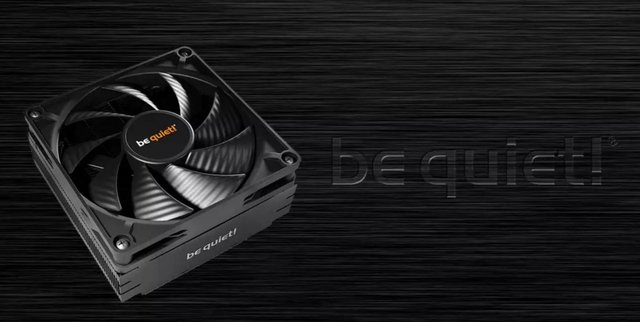-
be quiet! Pure Rock LP
Introduction
This review focuses on the smallest low profile coolers for the ITX platform. be quiet! has once again introduced an exciting new CPU cooler. It goes by the name of be quiet! Pure Rock LP and is characterized primarily by its compact height, thanks to which it can also fit into smaller cases. It is only 45 mm high. Compact systems and mini-ITX towers get a comparatively flat CPU cooler with the new be quiet! Pure Rock LP, which nevertheless wants to score with a convincing performance. It is only 45 mm high and thus fits into just about any case. This makes it significantly flatter than the Pure Rock Slim 2, for example. Its compact design still allows full utilization of the RAM banks. beQuiet! states the TDP value is 100 W. So the Pure Rock LP can handle some processors without power limits at its maximum, for example the Core i5-12400.

As usual, we will start with a long list of specifications. This beQuiet! cooler is, unlike the NH-L9 coolers, made so that the same design supports both AMD and Intel platforms. Noctua has a separate cooler for AMD processors (NH-L9a-AM4/chromax.black) and a separate one for Intel (NH-L9i-17xx/chromax.black). The big advantage of the Pure Rock LP is the support of the AMD AM5 platform. For the Noctua NH-L9a, it probably won’t arrive until sometime in the first quarter of 2023. Pure Rock LP supports all the latest (AMD AM5/Intel LGA 1700) and older (AMD AM4/Intel LGA 1200 and 115x) mainstream platforms for which this cooler is sufficient in performance.

Packaging & Contents
The front of the packaging carries a sleek black design. One that’s clearly intended to tie into the black aesthetic of the cooler. With it giving you a nice clear look at the cooler, however, along with the main key features, this certainly ticks all of the right boxes in terms of initial presentation.

The rear and side of the packaging give you loads of technical specifications regarding the Pure Rock LP and, as such, from just a quick look you’ll know exactly what you’re getting here down to the most precise detail.

The features of the cooler are highlighted here.

It may initially surprise you to find that in terms of accessories, there are surprisingly few with the be quiet! Pure Rock LP. While we will go into more detail as to why this is in the ‘installation’ aspect of this review, the short answer is that you don’t actually require much to fit this to your motherboard/CPU.

In addition to all this, be quiet! has included a leaflet to show you how to install the cooler. The instructions are generally clear with easy to understand instructions.

A Closer Look
The Pure Rock LP is 92 mm wide, 92 mm deep and only 45 mm high with the fan. In terms of weight, the Pure Rock LP weighs 358g. This is a very compact cooler and the weight makes it feel dense.

be quiet's own logo can be found on two sides of the heatsink and is generally hidden once it is installed.


From the side, you can see all of the fins are stacked in a rectangular shape. There are several indents and teeth on both sides of the metal fin edges. This optimizes the ability to permit airflow in between the fins while reducing the resistance and noise, all while only negligibly decreasing the heatsink surface area. There is a dense network of 56 aluminum fins.

It doesn’t look like it, but it has a total of three 6mm copper heatpipes each. These are well hidden thanks to two side plates.

All the joints are cleanly soldered at the base while the heatpipes are soldered to the fins. The base is made of copper, but not nickel-plated. It already has a layer of thermal paste on it.

The Pure Rock LP has a rifle bearing PWM fan(only 15mm thick), which can be replaced with another 92 mm model with a reduced profile at any time if required. This is also one of the advantages over, for example, the aforementioned Cryorig C7 cooler, which has a non-standard fan mount. It has been equipped with nine fan blades. The fan blades match those of other be quiet! fans with the well-known wave structure, which contributes to the reduction of noise-causing air turbulence.

The fan has a maximum speed of 2500 rpm. A 4-PIN PWM black ribbon cable is used as the connection cable.

The fan's frame is basic, square-shaped, without silentblocks to reduce vibrations.

Installation Process & Finished Looks
As you have read in our other be quiet! reviews, installation is pretty straightforward. However, this compact cooler uses a different system compared to the traditional mounting setup. The heatsink is screwed from behind the motherboard, therefore it must first be placed on the processor and then, being careful not to let it slip , it must be turned together with the block and you have to insert the screws in the backplate.

The Pure Rock LP cooler is not much taller than the DIMM heat spreaders. Which once again shows how small the height of the cooler is. This CPU cooler is small enough so there is no part hanging over into other areas on the motherboard like the RAM slots or VRMs. Once again, these dimensions suggest to users that this cooler is meant to be used in tighter areas and applications like a home theater PC.

Performance
Test config:
Motherboard: MSI MAG Z690 Tomahawk Wi-Fi
Intel processor: Intel i5 12600KF
memory: 2 x 16 GB Corsair Vengeance DDR5 5200MHz
SSD: Samsung 980 Pro 512 GB
graphics card: RTX 3060Ti
power supply: Corsair HX750 Platinum
Thermal paste: Noctua NT-H1

We have slightly modified our test protocol to adapt to the cooling capacity of this type of cooler.
We had carried out a first test with our i5 12600KF @ stock, but even with the ventilation set to its maximum speed, this type of cooler shows its limits in effectively cooling our processor once subjected to an OCCT session. The temperature of the cores easily reached the critical threshold of 100° C.
This meets the specifications that can be read on the compatibility list concerning the Pure Rock LP which defines optimal cooling only with a turbo frequency moderate. Having no other processor at our disposal, we simply modified the frequency of our i5 12600KF and deactivated its 4 Efficiency cores (E-cores) so that it approximates the characteristics of an i5 12400.We took into account that the turbo frequency on all the cores is limited to 4 GHz and therefore set the frequency of our i5 12600KF to this value throughout the OCCT test. Ambient room temperature taken using a digital thermometer fitted with two thermocouple probes.
Recording of the temperature peaks of each “Performance” core (P-core) of our i5 12600KF using the HWiNFO64 v7.16 software. The value transcribed on the table is the average of the 6 “Performance” hearts.
The fan speed is set in the bios to 100%.
The bios @ stock is configured in XMP.
We only perform an OCCT test with the ventilation set to its maximum speed.
For the moment, we are comparing the Pure Rock LP to the original Intel cooler that accompanies an i5 12400.The ambient temperature of the room is taken into account when reading the results. The values are expressed in delta, subtracting this ambient temperature from the temperature read.
If the value is equal to 0, one of the 6 “Performance” cores has reached the critical threshold of 100° during the OCCT session.

It is clear that the be quiet! Pure Rock LP is much more efficient than the original Intel cooler with a difference of ten degrees. However, we found during our tests that this type of cooler cannot afford to cool a processor such as our i5 12600KF in good conditions, at least when the latter is used at 100%.
Anyway, this is the kind of cooler that you get to install it in mini PC type boxes (HTPC or SFF) because of its very compact format and especially its low height. Dimensions that are more suitable for a configuration with low thermal release such as an i5 12400 associated with a motherboard in mini ITX format.
Final Thoughts
A really low-profile CPU cooler. That’s the thing beQuiet! didn’t have in its offer until now. With the 45 mm tall (or rather short) Pure Rock LP, the situation changes. Compared to many competing solutions, this cooler has the advantage of wider compatibility. Mainly, it supports the AMD AM5 platform which surprised some small top-flow coolers and took them off the compatibility list. The main purpose and idea of this set of coolers is that they should fit in smaller areas and tighter quarters where a low profile is necessary. Considering these are even smaller in height than the stock cooler options from Intel, the focus is compatibility. From the beginning, we can see the great build quality and excellent looks on the be quiet! Pure Rock LP. I have said this two times already, but I really appreciate the Pure Rock LP style from be quiet!, in the sense that it looks clean and stealth-like. As a be quiet! product, however, you already probably know that in terms of design and functionality, despite this being small, its still a very hefty product in terms of features. The heatsink looks great with its black brushed aluminium finish, inside of which we find three 6mm heatpipes hidden by two side plates featuring be quiet’s logo and carrying heat from a copper base plate. The latter comes with pre-applied thermal paste. When we look at performance metrics, the Pure Rock LP does not boast superb cooling, but it is quite acceptable for its size. The single 92mm fan attached does get a bit loud under full load, but should stay quiet in regular circumstances. However, for quieter operation, you will need to limit the power draw to around 65 W and for very quiet operation to somewhere around 35 W. Unlike its tower-style counterparts, the design provides more airflow around the VRMs thus improving their temperatures, especially important in dense, small-form-factor builds. Yes, the air will be hot, but even 50 or 60°C air will still cool a +70°C VRM. And when you have a teeny, tiny case with no additional space for fans, this becomes even more useful.

Unlike Noctua‘s NH-L9 series where there are two heatsinks per platform (Intel or AMD), the be quiet! model comes with everything necessary for mounting on both motherboards. No need to buy an Intel or AMD specific heatsink! Once again, the performance is indicative of the low-profile nature of this cooler, and really is not surprising. Pure Rock LP is available at an MSRP of $49.90 / €49.90 / £46.99. The cooler comes with a full 3-year manufacturer's warranty.

Last edited by testman78; 01-04-2023 at 04:13 AM.
 Posting Permissions
Posting Permissions
- You may not post new threads
- You may not post replies
- You may not post attachments
- You may not edit your posts
-
Forum Rules


























 Reply With Quote
Reply With Quote

Bookmarks